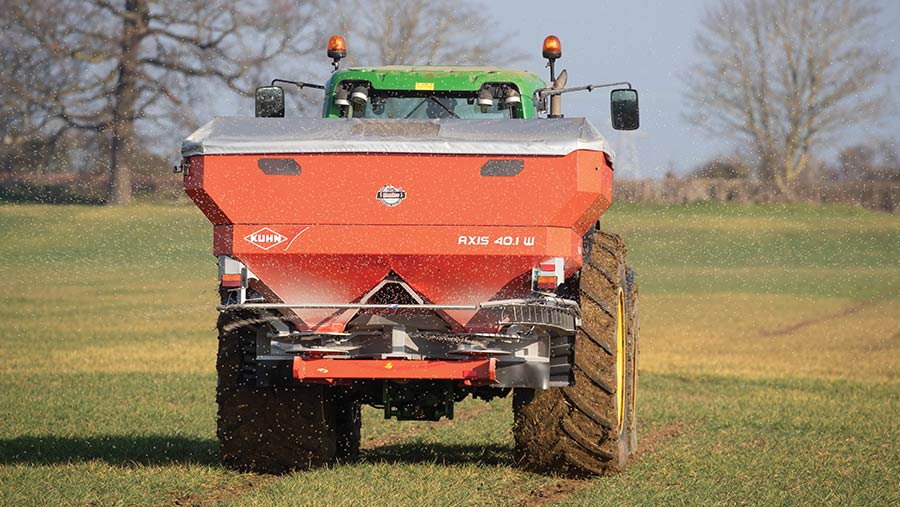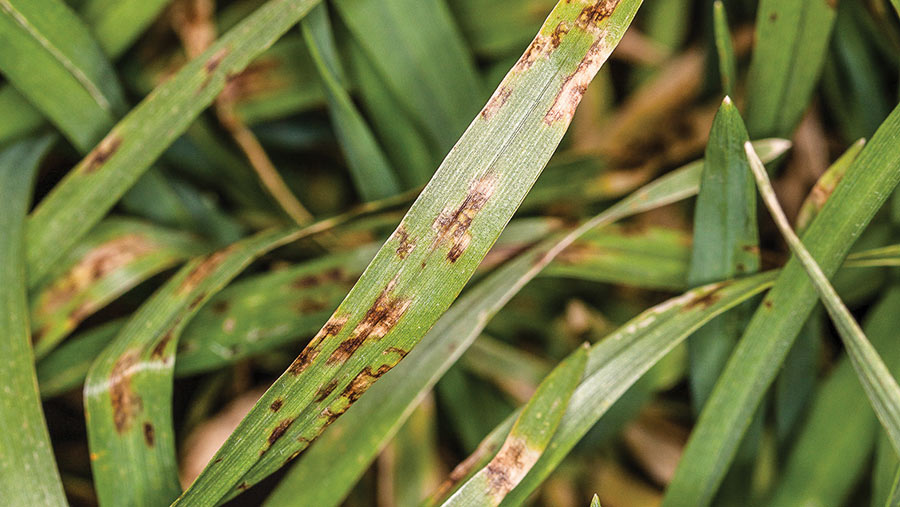Crop Watch: N applications are top priority for most crops
 © Tim Scrivener
© Tim Scrivener With a slightly drier few days forecast, the immediate focus will be on nitrogen applications to most crops, especially the winter OSR which is now at or beyond green bud.
Thoughts are also turning to disease control in winter barley, as the T0 timing approaches and with wet weather diseases such as net blotch and rhynchosporium already being seen in crops in the south.
But this all relies on fields drying out and fingers will be crossed that conditions improve so that spreaders and drills can leave the shed.
See also: How to achieve success with IPM2 flower-rich margins in SFI
North
Mary Munro – AICC/Strutt and Parker (Perthshire)
February often seems a very short month – this year it felt long and very wet.
March has started quietly and a couple of dry days did a lot to raise the spirits, but most soils have a lot of drying to do before they are workable.
Fertiliser spreaders have barely been put into action yet, applying early nitrogen to OSR and winter barley.
Many fields are too wet and patience is needed before any serious activity can be contemplated.
Getting clopyralid onto OSR is one of the first priorities. The window of opportunity is almost impossibly short; from 1 March to green buds visible from above; and last year we failed to get it on.
Clopyralid is so good on mayweeds and thistles (including sowthistle) that every effort will be made to use it if at all possible.
The OSR crops look all right – there is a bit of disease in some, and rather a lot of pigeon damage in others, but ground cover is acceptable in East Lothian.
Too thick
Other parts of the country have not fared so well through the storms and floods earlier in the winter, but my local growers can be pleased with things so far.
Last year’s oilseed rape looked superb in the spring, but analysis of yields suggests they were too thick.
The rough rule of thumb with OSR is that you simply cannot predict the yield by the appearance of the crop.
Wheat crops are far more variable. The earlier-sown ones are greening up, tillering, and generally clean.
Wheat drilled after potatoes, or late for any other reason, has really struggled and some rotted out before it could germinate.
Rooting depth is poor (as always in wet winters) and the challenge for winter wheat will be getting the roots to grow down through the soil profile.
Winter barleys are looking hungry, but mostly clean. There is a bit of net blotch in some, but nothing too alarming.
I often skip a T0 on winter barley, but this year I feel they will benefit. They all get manganese in any case, and a robust plant growth regulator programme.
West
Stephen Harrison – AICC/Southwest Agronomy (Avon)
March may be the first month of meteorological spring, but the only springs showing here are those out in the fields.
Excess water has been the main, if not the only, talking point for months now.
Crops are showing an inordinate amount of variation.
Where we could drill in late September due to low grassweed pressure, crops have come through the winter well, with excellent performance from residual herbicides.
Mid-October drillings which caught the deluge have suffered to the extent that those crops sown just before Christmas look better.
Grassweeds are a major concern in the later drillings as in many cases pre-emergence herbicides could not be applied and now grassweeds are beyond the stage where they will be effective.
Combine this with low population, uncompetitive wheat crops which allow increased weed tillering, and resistance to contact herbicides, and all the ingredients are there for some scruffy crops.
Nitrogen priority
Immediate focus must now be on nitrogen applications to most crops.
Winter OSR which is now at or beyond green bud is now a priority, and I suspect fertiliser will have to be applied in two splits rather than our usual three.
The same applies for winter barley where yellowing crops are in danger of tiller loss which cannot be recovered.
We are unlikely to be able to apply spring contact broad-leaved herbicides to winter OSR, as the already narrow application window is rapidly closing.
I have yet to see significant barley yellow dwarf virus infection in winter cereals, which is one hopeful point.
Spring break crop plantings will be well down this year. Only maize and spring oats are likely to stay constant or rise.
Spring beans will be replaced by legume fallow. This will not be the case on my Welsh clients’ farms where there is massive concern over the changes to agricultural policy.
East
Becky Finbow – Agrovista (Norfolk/Suffolk)
Well, it wouldn’t be an update if we didn’t start with the weather – I’m writing this on the first day of March and it’s wet.
We continue to plan and hope for a day when we can travel on the land.
We managed to establish nearly all planned winter wheat crops, apart from some land after beet, which will be spring cropped.
Overall, about 70% of the wheats look good, 25% have lower yield potential and 5% have been written off.
Occasional breaks in the weather have allowed earlier drilled wheats to perk up, while January drillings have wet feet and are only very slowly starting to grow.
Earlier cereals received their pre-emergence applications. I’m adapting a programme for later-drilled stands, combining residual and contact chemistry.
These backwards crops are going to need a carefully managed nutrient plan.
It will start with a sufficient fresh phosphate source and some early nitrogen to encourage rooting and tillering.
This can be applied in foliar form using biostimulants to give an early kick to the plants before following up with the usual applications later when growth is more rapid.
Sulphur
On more forward cereal and oilseed rape crops, sulphur will be applied alongside the nitrogen to aid nitrogen uptake.
The timing, although already compromised by the weather, is going to be crucial to enable all crops to progress as well as they can through their growth stages.
In an ideal world the oilseed rape would have already had its first application of nitrogen-sulphur, especially as I have now seen a few crops extending quickly with green buds already apparent.
If you are lucky enough to have got your drill out or have made a start on spring cropping cultivations, please be aware of the number of slugs about.
I got home this evening to find two slugs making their way across my patio towards my lupins.
Cultivations are one of the most effective ways of reducing slug populations, particularly ploughing, although even minimum tillage considerably reduces slug damage compared with direct drilling.
Conditions now would indicate rolls to be redundant, but ensuring a fine consolidated seed-bed will help to prevent slugs from moving from seed to seed or plant to plant.
If you are planning to grow spring barley, now is the time to lay traps and check them regularly. I don’t think it will be long until you find the threshold.

Net blotch on barley © Blackthorn Arable
South
Jamie Swift – Procam (East Sussex)
As we progress through March I would like to be reporting on eager growers pushing ahead with drilling spring cereals, but as yet very few drills have left the shed, due to the obvious.
I need not dwell on the weather as we are all too aware of the continued rain holding up proceedings, whether that be drilling or catching up with delayed herbicide applications.
That said, when walking winter cereals, I have been pleasantly surprised at the overall condition of crops and how well they are faring, considering the extremely wet conditions.
Scarring from high slug pressure throughout the autumn and winter is still visible, but early drilled barleys are tillering well and will soon be approaching stem extension.
T0 fungicides are being lined up which will be particularly important this season due to high levels of “wet weather” diseases net blotch and rhynchosporium.
Early control is critical as both diseases can cause significant yield loss if allowed to become established in the crop.
OSR crops
Oilseed rape crops are a mixed bag. Many have suffered particularly badly due to poor establishment in the autumn paired with high rainfall through the autumn and winter.
Early-drilled crops are faring better, but cabbage stem flea beetle larvae are easy to find in even the healthiest of crops due to favourable conditions.
Canopy management will require careful consideration as green area index (GAI) is directly related to yield, and nutrition-based decisions are a key factor in the success of a crop of OSR.
Even with fertiliser prices dropping considerably in recent months, nitrogen applications must be approached on a field-by-field basis in order to achieve the correct GAI to maximise yield.
It would be hoped that any winter beans planted in the autumn have received a pre-emergence herbicide due to the lack of post-emergence options.
The rain will have washed some active ingredient away more quickly than usual, as well as hindering emergence of the crop. Indeed, some plants may not survive, but these factors could all contribute to a post-emergence herbicide becoming more necessary than usual.
Bentazone can be used as a single or split dose; the latter is more likely in winter beans where overwintered weeds are present.

